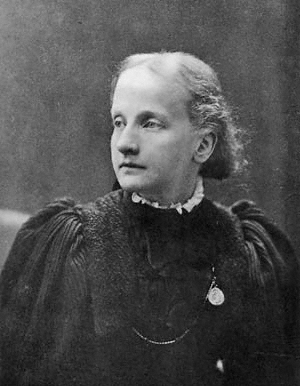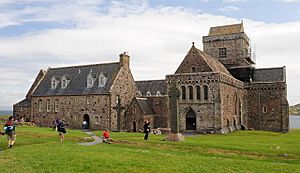Lady Victoria Campbell facts for kids
Quick facts for kids
Lady Victoria Campbell
|
|
|---|---|

Lady Victoria, c. 1895
|
|
| Born | 22 May 1854 Carlton House, London |
| Died | 6 July 1910 (aged 56) Edinburgh |
| Buried | Liberton Churchyard, Edinburgh |
| Father | George Campbell, 8th Duke of Argyll |
| Mother | Lady Elizabeth Leveson-Gower |
| Occupation | Philanthropist |
Lady Victoria Campbell (born May 22, 1854 – died July 6, 1910) was a kind-hearted British woman who spent her life helping others. She was born into a very important Scottish family. Her parents were George Campbell, 8th Duke of Argyll and Lady Elizabeth Leveson-Gower, who owned a lot of land in Scotland.
When she was a child, Lady Victoria got sick with poliomyelitis. This illness made her legs weak, and she needed to wear special leg braces for the rest of her life. Despite this, she dedicated her life to helping people.
In 1882, Lady Victoria decided to focus her life on helping those living on the islands around Argyll, Scotland. She often visited the island of Tiree. There, she supported groups that helped people and moved to the island in 1891. She also wrote letters to newspapers, sharing stories about the islanders' struggles.
Contents
Lady Victoria's Early Life
Lady Victoria Campbell was born in London on May 22, 1854. She was the third daughter of George Campbell, 8th Duke of Argyll and his first wife, Lady Elizabeth Leveson-Gower. Her family, the Campbells and Leveson-Gowers, owned huge amounts of land in Scotland.
She was named after Queen Victoria, who was the Queen at the time. Her grandmother was a friend of Queen Victoria. Lady Victoria was the only one of her twelve brothers and sisters who never got married. Her brother, John, was married to Princess Louise, who was Queen Victoria's daughter.
Childhood Illness and Recovery
When Lady Victoria was five years old, she got poliomyelitis. This illness caused her legs to become weak. She had to wear leg braces for the rest of her life. From 1859 to 1868, she spent most of her time in London and Brighton. This was so she could be near her doctor.
During these years, she was often away from her immediate family. However, her aunt and a loyal helper, Elizabeth Knowles, looked after her. Lady Victoria was especially close to her sister, Frances Balfour. Frances once said that Victoria's room was "the center of the fun" in their family.
Victoria had many treatments and surgeries to help her legs. After physical therapy, she learned to use crutches and walking sticks. Her sister Frances noted that Victoria rarely complained about her health. She had dealt with it since she was very young. In 1868, at age 14, Victoria became very ill with a lung infection. She continued to have chest problems throughout her life.
Family Care and Challenges
That same year, her mother had a stroke. Lady Victoria spent ten years caring for her mother. After her mother passed away in 1878, the stress of caring for her may have caused Victoria to have a difficult time with her health. After this, Victoria helped manage her father's homes until he remarried in 1881.
Helping Others: Lady Victoria's Philanthropy

Even with her difficulty walking, Victoria often visited poor families on the island of Iona. In 1882, during a visit to Iona Abbey, she felt a strong calling to help others. From then on, she dedicated her life to helping people living on the islands throughout Argyll.
A special plaque was later placed in the abbey. It says that Victoria dedicated her life to helping the people of these islands. In 1885, she started learning Gaelic, the language spoken on the islands. She even taught Bible classes in Gaelic. She also supported local artists and craftspeople. They made items inspired by Celtic culture. She helped bring back interest in Celtic Christianity in Argyll. Two of her students were Alexander and Euphemia Ritchie, who became famous Celtic craft makers.
Focus on Tiree Island
Lady Victoria first saw the island of Tiree in 1878 while on her father's yacht. In 1886, she learned about a problem between her father and the people of Tiree. The islanders were facing hard times. They wanted a farm to be divided into smaller plots called crofts. But her father leased it to someone else.
The islanders stopped the new tenant from taking the farm. This led to at least eight men being arrested. This event deeply affected Victoria. She started visiting the island more often and moved there in 1891.
On Tiree, Victoria strongly supported social and religious groups like the YWCA. She also organized soup kitchens to feed people. She helped set up training for both men and women. Men learned crafts like woodcarving. Women learned needlework and lace-making.
Lady Victoria wrote letters to British newspapers about the islanders' problems. She used the pen name 'Hebridean' to keep her identity a secret. The people of Tiree greatly respected her. They admired her determination to reach the island, even when the weather was bad and travel was dangerous.
Building a Pier for Tiree
Near the end of her life, Victoria worked hard to get a new pier built for Tiree. Traveling to the island was difficult and dangerous because there was no proper pier. Residents had asked her father for help many times, but he refused. He did not want to pay for it all himself, even though his daughter faced danger traveling there.
A new pier was finally built after her father's death. Victoria worked for twenty years to make sure it happened. The pier was completed shortly after she passed away. She died on July 6, 1910, from influenza and pneumonia in Edinburgh. She was buried in Liberton Churchyard. In 1911, her sister Frances wrote a book about Victoria's life.

